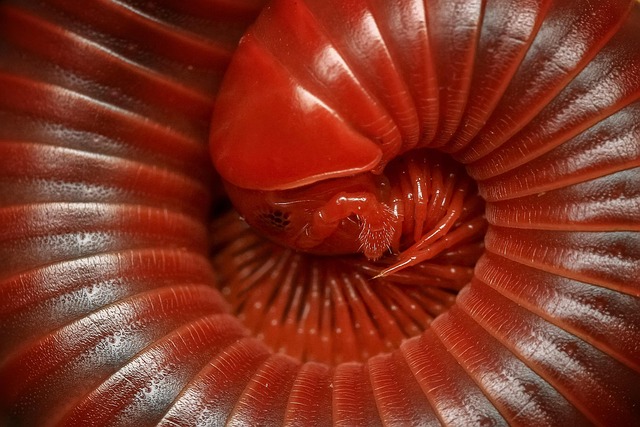Millipedes invade homes seeking damp, dark corners to feed on organic matter. They are attracted by moisture and clutter, especially in basements, bathrooms, and kitchens. To stop infestations, reduce humidity, fix leaks, seal entry points, clean regularly, and use natural deterrents like peppermint oil or diatomaceous earth. For severe cases, professional millipede control plans offer specialized solutions while preventing future intrusions requires ongoing cleanliness and dryness.
Tired of sharing your space with these multi-legged intruders? Understanding millipedes and their preferences is the first step towards effective millipede control plans. This guide offers expert advice on identifying common attractants and implementing strategic solutions. From understanding their behavior and habitats to long-term preventative measures, you’ll discover practical tips for keeping millipedes at bay. Say goodbye to unwanted visitors and reclaim your living space!
Understanding Millipedes: Behavior and Habitats
Millipedes are fascinating yet often unwelcome inhabitants of our living spaces, especially when their presence indicates a potential infestation. Understanding their behavior and preferred habitats is the first step in implementing effective millipede control plans. These creatures are not independent wanderers but tend to cluster together in dark, moist areas, making them more noticeable during certain times of the year. They prefer to dwell in hidden corners, such as behind appliances, under carpets, or within wall cracks, where they can remain undisturbed and feed on decaying organic matter.
Their behavior includes a slow, methodical movement, often described as a wave-like pattern, which helps them navigate through narrow spaces. Millipedes are particularly attracted to areas with high humidity, making basements, bathrooms, and kitchens common hotspots for their presence. By identifying these habitats and modifying the environment accordingly—ensuring proper ventilation, reducing moisture levels, and sealing entry points—homeowners can significantly deter millipedes from taking up residence in their spaces.
Identifying Common Millipede Attractants
Millipedes are drawn to certain elements in your home or garden, making some areas more attractive than others. Identifying these attractants is a crucial step in implementing an effective millipede control plan. Common factors that lure these creatures include moisture and organic materials. High levels of humidity, especially in dark, damp spots, create ideal conditions for millipedes to thrive and reproduce. Therefore, reducing standing water sources and improving ventilation in humid areas can significantly deter them.
Organics such as dead leaves, wood, or plant debris provide shelter and food for millipedes. Regularly removing these materials from your space can help curb their presence. Maintaining a clean environment, especially in basements, attics, or outdoor areas with accumulations of organic matter, is essential to keep millipedes at bay. Additionally, sealing entry points like cracks, crevices, and gaps around doors or windows prevents them from infiltrating your living spaces.
Implementing Effective Millipede Control Strategies
Implementing effective millipede control strategies requires a multifaceted approach, combining environmental adjustments with preventive measures. One key strategy is to reduce moisture levels in affected areas. Millipedes are attracted to dark, damp spaces, so eliminating sources of excess humidity can significantly deter them. This may involve fixing leaky pipes, improving ventilation, and ensuring proper drainage around your property. Regularly cleaning and vacuuming can also help eliminate millipede habitats, as can sealing entry points like cracks and gaps in walls or floors.
Additionally, maintaining a clean and clutter-free environment is crucial. Removing piles of leaves, wood, or other organic materials provides fewer hiding places for millipedes. Using natural repellents like peppermint oil or diatomaceous earth can further discourage their presence. For more severe infestations, professional pest control services specializing in millipede control plans offer effective solutions tailored to your specific needs.
Preventative Measures for Long-Term Millipede Management
To implement effective millipede control plans, preventative measures are key for long-term management. Regularly cleaning and maintaining your space is crucial; vacuum thoroughly to remove any visible signs of millipedes or their shedding skin, and wipe down surfaces with a damp cloth to eliminate dust and debris, which can serve as hiding spots.
Sealing entry points is another vital step in your millipede control plans. Inspect your home for cracks, gaps, or openings around windows, doors, and utility pipes, and seal these areas using caulk or appropriate materials to prevent millipedes from entering. Keeping your space dry is also essential; millipedes are attracted to moist environments, so addressing any leaks or high humidity levels can significantly deter their presence.
In summary, effective millipede control begins with understanding their behavior and identifying attractants in your space. By implementing strategic measures like regular cleaning, sealing entry points, and maintaining humidity levels, you can significantly reduce their presence. For long-term management, preventative measures such as lawn care and debris removal are crucial components of any successful millipede control plan.
